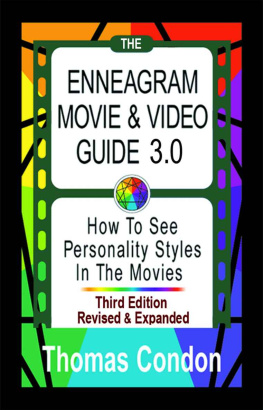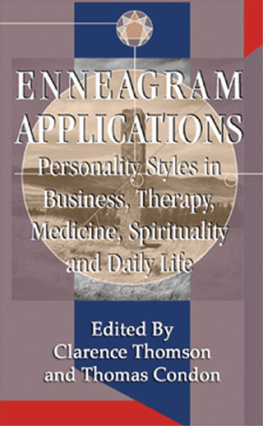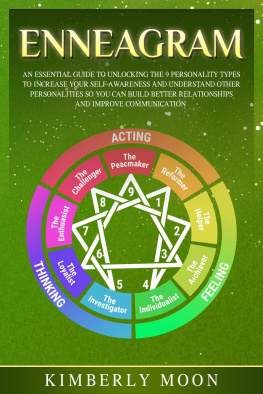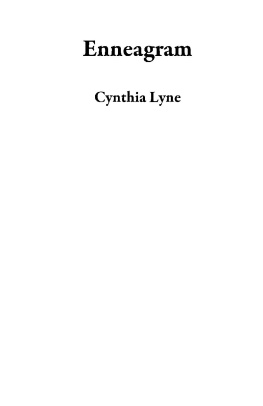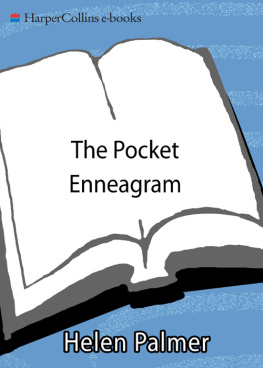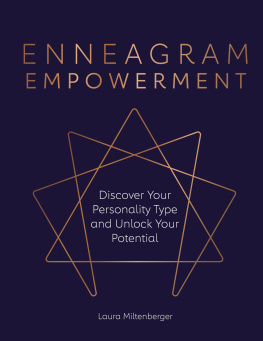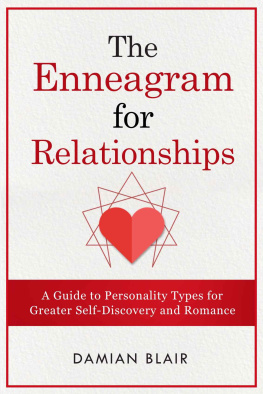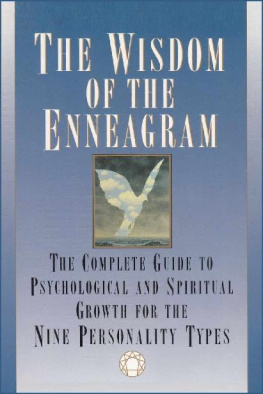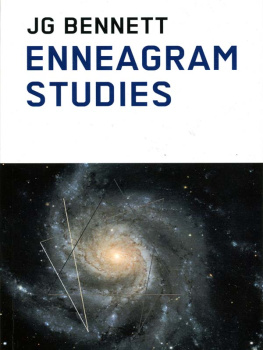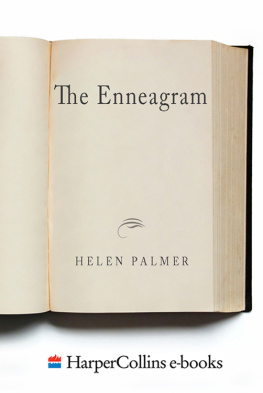Acknowledgements
The genesis of the Enneagram is generally credited to Oscar Ichazo. He developed the material as a spiritual tool, giving the model its bones and internal organs. Chilean psychiatrist Claudio Naranjo gave it flesh when he took the Enneagrams character descriptions and cross-referenced them with the distinctions of modern ego-psychology.
I first encountered the Enneagram in 1979 where it was being widely taught in the San Francisco Bay Area. I took workshops from Helen Palmer, Claudio Naranjo and others during this time. Many of my friends were psychotherapists and knew about the model; we colluded with and inspired one another. Past these student days I took the material and went my own way with it.
Each author of a book adds a perspective to the Enneagram. I especially like works that concentrate on descriptions of people rather than theories about them. The two works closest to textbooks on the Enneagram are The Enneagram, by Helen Palmer and Personality Types, by Don Riso. Both have theoretical trimmings but offer solid core descriptions of the styles. Palmers writing is born from years of passionate research and practiced observation of real people. Don Risos descriptions of healthy-to-unhealthy expressions of each style are helpful to people who might otherwise find the model damning and his insights into the wings are excellent. I also liked Richard Rohrs book, Experiencing the Enneagram, Claudio Naranjos Ennea-type Structures and Margaret Frings Keyess Emotions and the Enneagram. From all these people I have learned and extend my thanks.
Enneagram teachers are like blind people describing an elephant, each one clueing into a different aspect of the same animal. As far as possible, Ive tried to stick to my own wording and point of view but some influence is inevitable. I apologize for any overlap in my listings of real people and the listings in other books. Some famous people that we agreed about were just too pertinent to leave out.
This book is partly based on a regular column that I wrote for the Enneagram Educator magazine, now online as The Electric Enneagram. Clarence Thomson is my editor and friend, and he provided both the context and enthusiastic support for the development of the material. Clarence and I knew we had something when we learned that Educator readers were forming study groups just to watch the movies recommended in the column.
The physical production of this book has benefited greatly from the coaching of my friend, publisher David Balding. Thanks also to Lori Stephens for her phone-tech support.
Finally, this book owes a lot to a broken hip. I had a sports accident followed by surgery and a long passive recovery. I searched hard for the accidents possible usefulness before one day realizing, Hey! I can review 300 more movies! This book is thicker and better thought-out than it would have been for that calamity.
Foreword
Movies are bigger than life, but they are not different from life. If they were, we could not see ourselves in them and we would lose interest. They reveal us to ourselves whether we know it or not, whether we like it or not.
With a few spoken lines, movie characters can express the inner geography of their psyches with a clarity and force that people in real life usually lack. A good movie becomes clearer than life, because in two hours it can reveal the essence and true motivations of a human being.
In reviewing movies for their Enneagram styles, Condon has crafted his own art form. A spoken line here, a telling gesture there, reveal to this skilled teacher the underlying moods and motives of a movie character. Reading his reviews is like having a gifted observer show you where to look through a microscope, or having a docent point out an artists logic as you stand and see what you never saw right before you. The reviews in this book will show you Enneagram types writ large and writ vividly. Condon points out the obvious and suddenly you see it.
The dramatic evidence of the presence of Enneagram styles in films will encourage students of the system. It appears that, regardless of the imaginative process involved, when writers create a character, that character can often have an Enneagram style.
The clarity of the reviews and the sheer number of examples in this book will reinforce the confidence so many people place in the system. Using the book will also give you your own confidence at recognizing the outward signs of each style.
So may I humbly suggest that you gather around a good movie, read its review and tuck away Condons stylish observations for later verification. Then sit back, relax, and watch the most enjoyable audio-visual aids in the history of education.
Clarence Thomson, Author
Parables and the Ennegram
Introduction
The Enneagram is about peoplehow we are the same, how we are different, what makes us tick. It presents a system of psychology that describes nine core personality styles that human beings tend to favor. The descriptions of these styles are both profound and comprehensive, detailing the inner motivations, thought patterns and basic beliefs of each one. Newcomers to the Enneagram are often astonished to discover clear, accurate portraits of themselves, their friends, parents and intimates.
Part of the power of the Enneagram is that it recognizes how human beings have sincerely different versions of reality. No version is presented as better than another. Each of the nine styles has its own internal logic and integrity. Each correctly perceives part of reality and has an area of expertise. Each style has strengths, talents and advantages as well as limits, pitfalls and blind spots.
Enneagram styles are like nationalities. While we are all unique individuals, we belong to a larger group of which we are individual examples. If you have friends from other cultures, you know that on one level you are very aware of the differences between their culture and yours. The fact may contribute much to your relationship. On other levels, you and your friends connect affectionately in a way that bypasses how your cultures make you different.
Studying the Enneagram will reveal the differences between your psychological orientation and those of other psychological nationalities. With this awareness you can also connect more compassionately or usefully to others who have world views distinct from your own.
The major advantage to learning the Enneagram, of course, is to discover your own personality style. This can be a startling experience at first, but its usefulness soon emerges. Once you identify your core style, baffling aspects of your own behavior may suddenly make sense. You might see more clearly why you sometimes think and act the way you do. As you tune further into your own inner workings, you might sense deeper beliefs, plus a way of seeing the world that shades your daily actions and relationships.
You might also become aware of the ways you are caught up in the pitfalls of your style and cause yourself suffering. There could be little psychological traps you set for yourself, limits you place on your experience or habitual ways that you react to events without choice.
These insights can be helpful in that they provide motivation to work on ones self. Some responses that you now have may be outmoded and carried over from childhood. You may act blindly at times. To an extent, you may find that your Enneagram style amounts to something like a hypnotic trance, as though part of you sleepwalks through life, relating to an idea of the world, rather than the world itself. Seeing the map but not the territory, this is called.
Most psychotherapists would say that just having insight into your behavior is not enough to change it. Learning about the Enneagram wont magically transform you, but it will give you a tool that is greatly clarifying and uncannily useful.

